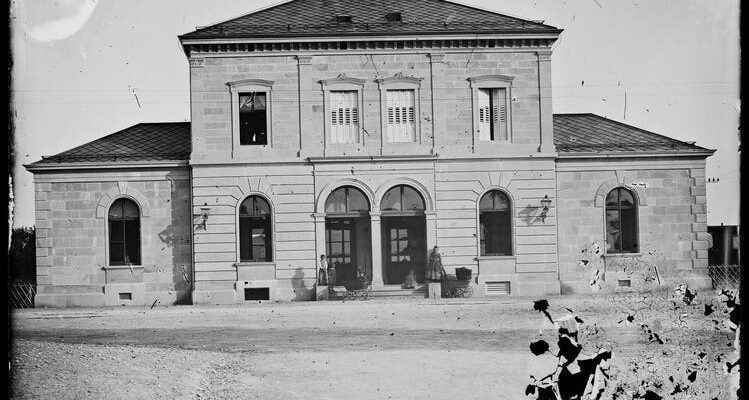Zug and Zurich are linked by a pretty railway history episode. The representative station building in Wollishofen was still in Zug 125 years ago. Now it is returning to its old homeland, in a special form.
The first Zug train station building from 1864, photographed in Zug, was dismantled in 1897 and rebuilt in Zurich Wollishofen. It is still there today.
Train stations, this is as banal as it is undisputed, are places for travelers and travel. Nevertheless, it doesn’t happen too often that train stations themselves go on trips. This is all the more rarely the case when they dominate the room like a stone monument to a new epoch, a turning point in time, so to speak. And yet it happens.
125 years ago, what was then Zug station was moved to Zurich Wollishofen, where it still stands today and has housed a restaurant for some time. It will soon be expanded (see box). Previously, the representative solid building in the Neo-Renaissance design language had served as the train station for the city of Zug for just 33 years.
A move like no other
The building, erected in 1864, was the first train station in Zug and was thus the tangible expression of a new age in the previously rural canton of Zug; industrialization was soon to follow along with the railroad. Zug’s first train station was roughly where the Reformed Church is today, i.e. at Bundesplatz. Over time, a second (1897) and a third train station building (2003) were to follow – albeit a little further north.
In the 19th century it was not uncommon to move smaller, mainly wooden stations, because building materials were expensive and labor cheap. This type of building recycling was therefore an expression of a commercial consideration by investors and builders. For example, the former Cham train station was dismantled in 1893, put into storage and rebuilt in 1900 in Bäch in the canton of Schwyz, where it still stands today. But sending such a massive and representative station building as the first Zug station stone by stone on such a long journey – that was anything but ordinary.
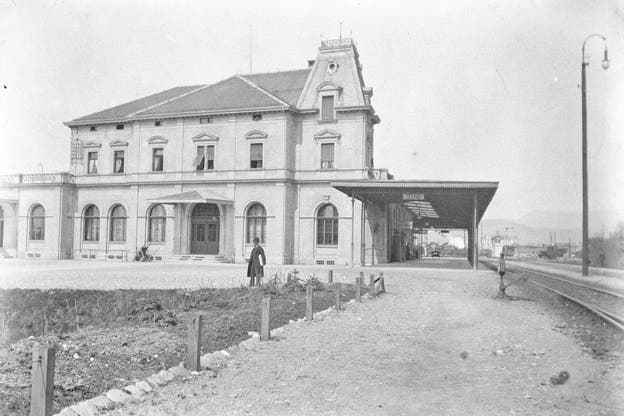
The second train station building in Zug, erected in 1897, photographed in 1899. The tracks of the Gotthard railway between Arth-Goldau and Zurich can be seen on the right edge of the picture.
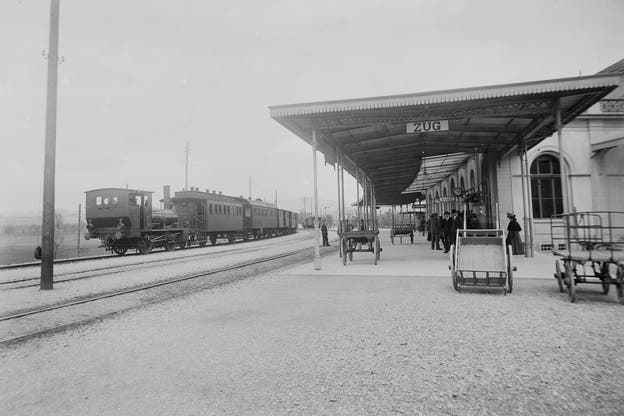
The building was used until 2001 and then demolished.
The second train station building in Zug, photographed in 1899: Zug lost its first train station 125 years ago, but gained a new one and at the same time a connection to the world.
In fact, the move of the first train station in Zug to Wollishofen has remained a unique process to this day. According to the inventory sheet of the Canton of Zurich for the preservation of monuments from 2020 for Wollishofen station, no comparable case is known in Switzerland. What’s more: according to the inventory sheet, Wollishofen station, formerly Zug station, was built in 1864 and is actually the oldest stone station building in the city of Zurich.
But how did it come about that Zug station moved to Lake Zurich in 1897? The answer to this question lies in the Zimmerberg and Albis puncture. This made the Zürichseebahn on the left bank and the Sihltalbahn the Gotthardbahn feeder. As a result, Zug was to become a hub of the railways. From then on, three lines met here: those from Lucerne and Affoltern, those from Thalwil and those from Arth-Goldau. Business circles in Zurich in particular called for Zug to be connected directly to the route to Italy, writes the historian and former Zug state archivist Ignaz Civelli in an article on Zug’s railway history.
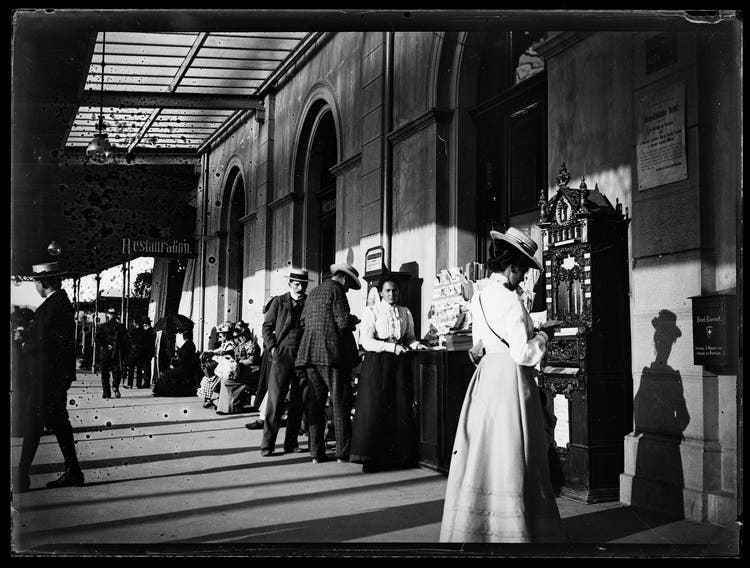
Passers-by at the second train station in Zug: the picture was taken between 1897 and 1907. The old station building was replaced in 2001.
From head to wedge
This fundamentally changed Zug’s transport-strategic importance. Before this infrastructural expansion, Zug was still on the railroad periphery. The Zurich–Zug–Lucerne line through the Knonauer Amt was completed in the 1860s by the Nordostbahn (NOB) after the Ostwestbahn had gone bankrupt. The development of the city of Zug was not a priority; From 1864, Zug could only be reached via a branch line from Cham and was given a terminal station.
The new situation in 1897 changed that. The dead end of Zug became a junction. The first train station in Zug, which unmistakably bears the signature of NOB house architect Jakob Friedrich Wanner, was no longer able to meet the new requirements. Zug was given a larger wedge station a little further north. As a result, the old train station was demolished stone by stone under the direction of the respected Zug master builder Johann Landis and rebuilt in Wollishofen, where a larger station was also needed. This is remarkable in that Johann Landis, so to speak, moved the showpiece of his father and predecessor Leonz Landis to Zurich with the first train station in Zug.
The fact that the first train station in Zug has been preserved for posterity in this way is a stroke of luck in terms of architectural history. Since a whole series of Jakob Friedrich Wanner’s buildings no longer exist or are no longer visible due to conversions, “the Wollishof reception building has great testimony to the overall work of the architect who shaped the entire catchment area of the NOB,” says the inventory sheet of the monument preservation department.
Although Zug lost its first station 125 years ago, it gained a second one and at the same time the connection to the world. Zug is celebrating this truly groundbreaking change in the economic history of the Canton of Zug with a party on September 3rd. For this reason, the first train station in Zug is returning to its original location at Bundesplatz. However, there is no need to worry about Wollishofen train station. This time the train station is not rising in stone, but as an airy image of itself in the form of an exhibition pavilion on Zug’s railway history.
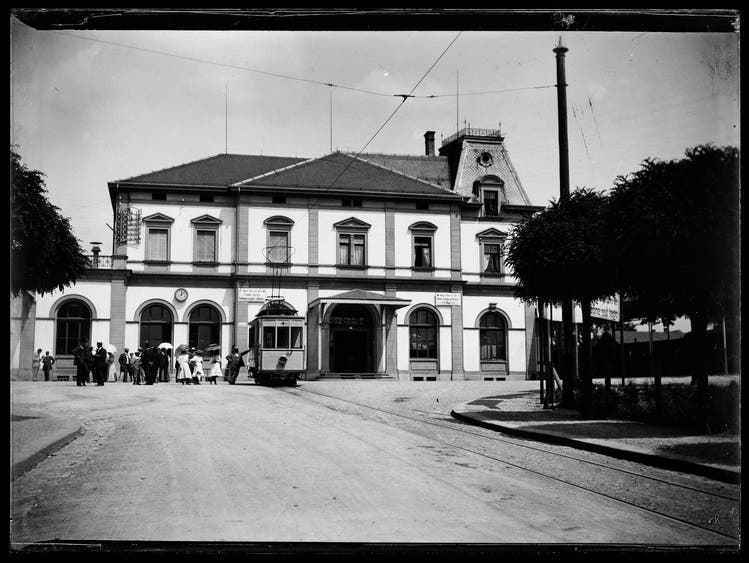
The second train station in Zug with the Zug–Schoenegg tram line, which opened in March 1907.
The goods shed in Wollishofen also travels
bye. The tradition of stations – or at least elements of them – going on a journey continues into the 21st century. And this, of all places, starting from Wollishofen station. The SBB are planning to redesign the station area there from 2025. The listed station building, which was originally built in Zug, will of course remain.
But the Wollishof goods shed from 1928, which was repeatedly used as a party venue, has to go. The building dates from 1928. The shed is a witness to early electrification and is a protected object of cantonal importance. In order to make room for the redesign of the station area, the goods shed will be dismantled, rebuilt at Bauma station and handed over to the Zürcher Oberland Steam Railway Association.
The Dampfbahn-Verein Zürcher Oberland (DVZO) has also owned the first concourse in Basel since 2015. On closer inspection, an inconspicuous hall in the Olten SBB industrial plant turned out to be one of the first two platform halls in Basel from 1860. It was dismantled in 1905 and rebuilt in Olten. It served as a storage shed and carpentry shop for more than a hundred years.
As a happy coincidence, their dimensions, 101 by 17 meters, corresponded exactly to the area available in Bauma near the train station, as the NZZ reported before the inauguration in 2015. The SBB and the DVZO soon agreed to give this monument of railway architecture its former purpose again. In 2011, the cantonal council approved a contribution of CHF 2.6 million from the lottery fund. The following year, the hall was dismantled a second time and has now been reconstructed true to the original next to the SBB train station. The cost of reconstructing the station concourse totaled CHF 5.7 million.
The “Wellenlänge” project planned for Wollishofen station is to be implemented in two stages. First, the station square will be expanded with a residential building and a partially covered square. At the same time, a multi-storey city villa is being built in the adjacent northern district park. With the redesign of the station square and the building that takes the place of the signal box, covered bus stops are being built. In addition, the connection to Lake Zurich is to be improved.
Around 90 apartments are being built in the superstructure, a third of which are inexpensive, as the SBB write in a communiqué. There is also space available for catering and retail.
